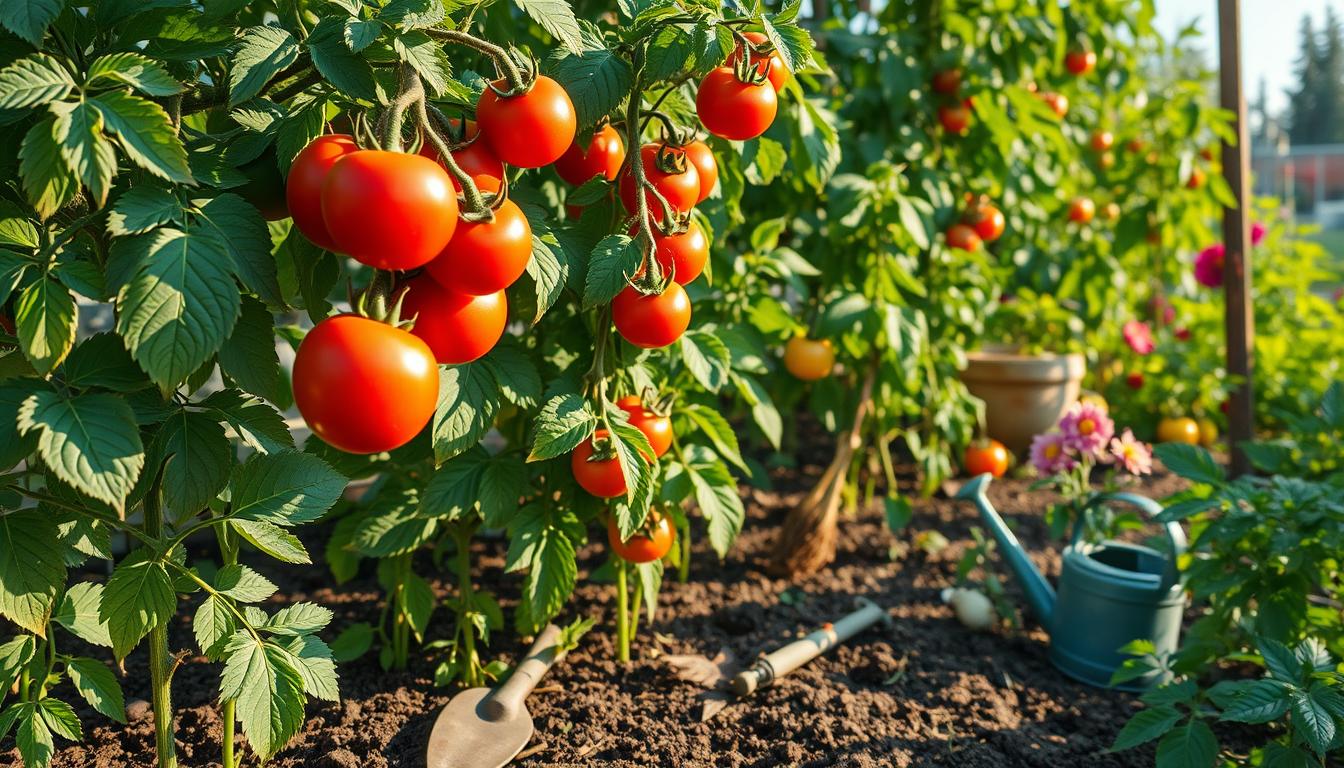I’m excited to share my knowledge on how to grow tomatoes with you. Growing delicious tomatoes at home is rewarding. With the right techniques, you can enjoy a bountiful harvest. It’s important to learn the basics and follow valuable tomato growing tips.
In this guide, I’ll show you how to grow tomatoes from seed to harvest. We’ll cover everything from choosing the right variety to providing optimal care. Whether you’re a beginner or an experienced gardener, I aim to give you the info you need. This way, you can grow mouth-watering tomatoes at home using proven tips.
Why I Love Growing Tomatoes
Growing tomatoes is a rewarding experience. I love watching a plant grow from seed to harvest. The joy of eating a fresh, juicy tomato is unmatched. When choosing tomatoes, I consider the climate, soil, and my taste preferences.
Proper care is key for a healthy tomato plant. This means giving it enough sunlight, water, and nutrients. With these steps, anyone can grow tasty tomatoes at home.
The Joy of Fresh Produce
One reason I love growing tomatoes is the joy of fresh produce. There’s nothing like picking a ripe tomato from my garden. The taste and texture are better than store-bought, and I’m proud to have grown it myself.
Health Benefits of Homegrown Tomatoes
Homegrown tomatoes are full of nutrients and antioxidants. They’re rich in vitamin C, lycopene, and other vitamins and minerals. Growing my own tomatoes means they’re free from pesticides and harmful chemicals.
The Flavor Difference
The flavor of homegrown tomatoes is different from store-bought ones. They have a more complex taste, with sweet and tangy notes. This is because of the tomato variety and the care it gets while growing.
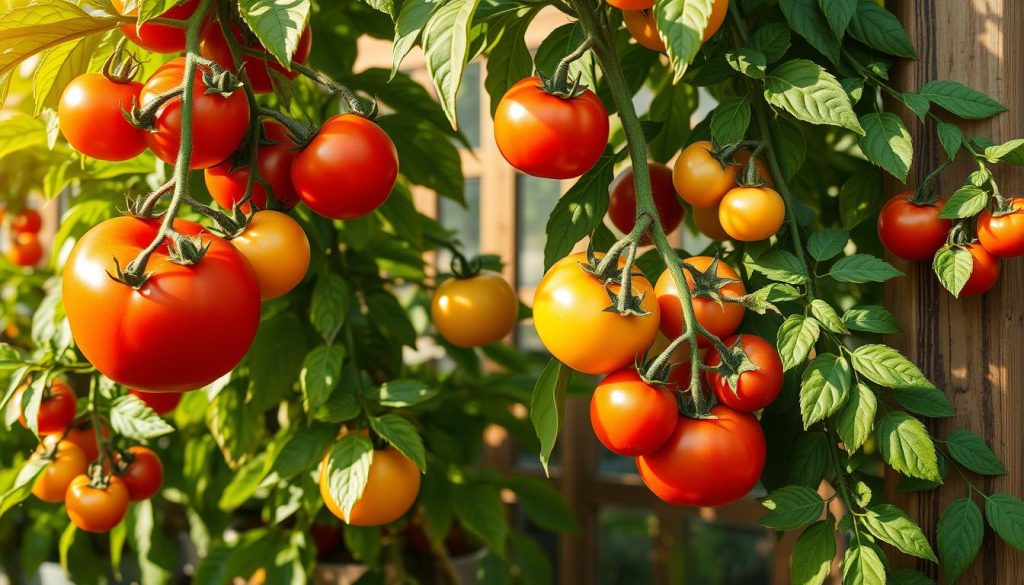
In conclusion, growing tomatoes is a fun and rewarding hobby. It offers many benefits, from fresh produce to health benefits. With the right care, anyone can grow delicious tomatoes at home.
Choosing the Right Tomato Varieties
Starting with tomato gardening can feel overwhelming with so many varieties. But, knowing the different types is key for success. Picking the right variety is crucial for a great tomato gardening experience.
Tomato plants come in two main types: determinate and indeterminate. Determinate plants are small, produce fruit all at once, and are best for canning and sauces. Indeterminate plants are vining, keep producing fruit, and are great for fresh eating and slicing.
Determinate vs. Indeterminate Types
Choosing between determinate and indeterminate plants depends on your space, harvest time, and tomato use. Knowing the pros and cons of each type is vital for a good tomato gardening guide.
Best Heirloom Varieties for Taste
Heirloom tomatoes are famous for their unique tastes and textures. Favorites include Brandywine, Cherokee Purple, and Black Krim. These add a special touch to your tomato growing.
Quick Growing Varieties for Beginners
Beginners should try quick-growing varieties like Patio, Tiny Tim, and Red Robin. They grow fast, ready in 50 days, and are perfect for small spaces and containers.
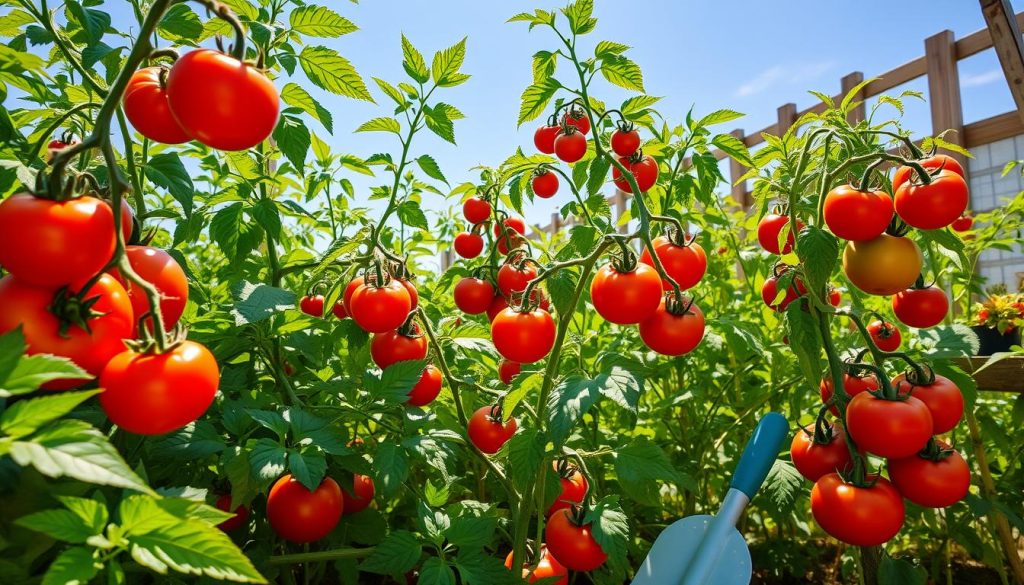
Learning about different tomato varieties helps you create a successful tomato gardening guide. It also helps you master growing tomatoes.
| Variety | Type | Maturity Days | Use |
|---|---|---|---|
| Brandywine | Heirloom | 70-80 | Fresh eating, slicing |
| Patio | Determinate | 50-60 | Canning, sauces |
| Cherokee Purple | Heirloom | 70-80 | Fresh eating, slicing |
The Right Time to Plant Tomatoes
Timing is key when growing organic tomatoes. To get a good harvest, planting at the right time is crucial. I’ll show you how to figure out the best planting time.
Understanding Frost Dates
Frost dates are important for planting. They change based on where you live. It’s safe to plant tomatoes after the last frost date. Check with your local nursery or extension office for your area’s frost dates.
Optimal Planting Season in the U.S.
In the U.S., planting times vary by region. Here’s a quick guide:
- In northern states, plant tomatoes in late May or early June. Wait until the soil warms up and frost risk passes.
- Southern states can plant in early spring, around late March or early April.
- If your winters are mild, plant in the fall, 8 weeks before the first frost.
Follow these tips to grow tasty, organic tomatoes. Always check your area’s frost dates and planting seasons for the best results.
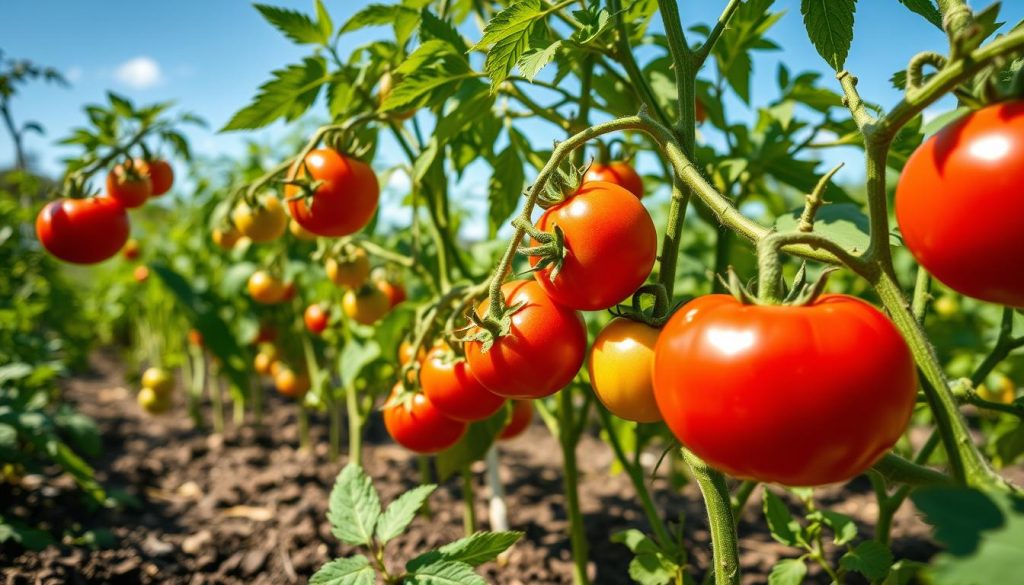
Preparing My Garden for Tomato Plants
To get a great tomato harvest, I need to get my garden ready first. This means picking the right spot, testing and fixing the soil, and adding nutrients. A good garden helps my tomatoes grow strong and healthy, avoiding diseases.
Choosing the Best Location
When picking a spot for my tomatoes, I look at sunlight, soil, and drainage. Tomatoes need lots of sunlight, so I pick a sunny area.
Soil Testing and Preparation
I test my soil to see its pH and nutrient levels. Then, I add compost or manure to make the soil better. This helps my tomatoes grow strong and healthy.
Adding Nutrients for Healthier Growth
To help my tomatoes grow well, I add nutrients to the soil. I use a balanced fertilizer with nitrogen, phosphorus, and potassium. I also add compost tea or worm casting for extra benefits.
By doing these steps, I make sure my garden is ready for my tomatoes. This way, they can grow well and give me a great harvest.
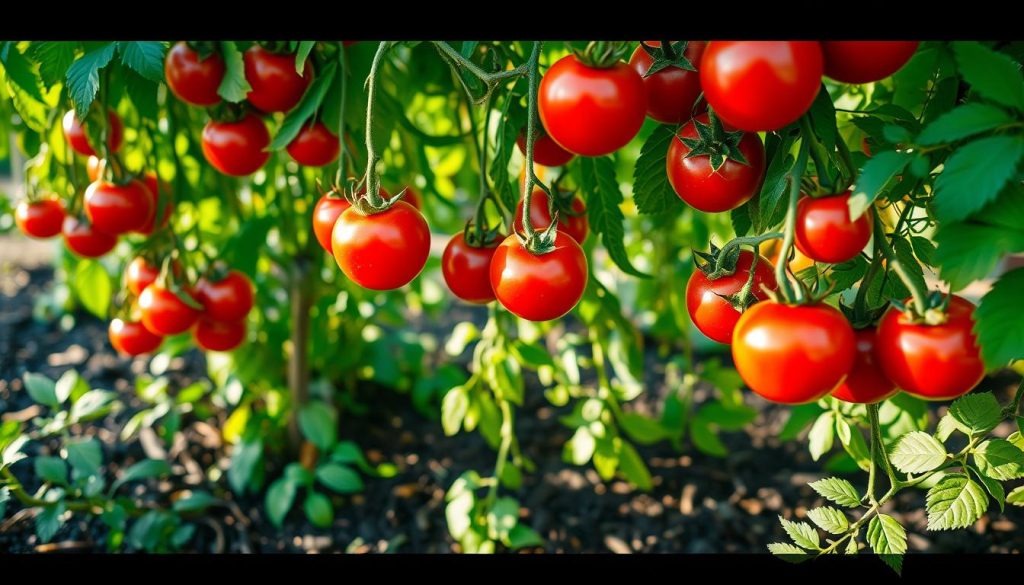
- Choose a location with plenty of sunlight
- Test and prepare the soil
- Add nutrients for healthier growth
How to Plant Tomato Seeds Indoors
Starting tomato seeds indoors gives them a jumpstart on the growing season. You’ll need seed trays, potting mix, and grow lights to begin. High-quality supplies are key to healthy, productive plants.
Here are some essential tips for planting tomato seeds indoors:
- Use a well-draining potting mix to prevent waterlogged soil
- Plant seeds at a depth of 1/4 inch and space them 2-3 inches apart
- Provide adequate light, such as grow lights or a sunny windowsill
Proper Planting Depth and Spacing
Getting the depth and spacing right is crucial when planting tomato seeds. Planting too deeply can harm germination, while too shallow can dry out seeds. Follow these tips for a successful start and a great harvest.
Caring for Seedlings Until Transplant
After germination, seedlings need the right care to thrive. Keep the temperature steady, provide enough light, and water carefully. With these tips and the right supplies, you can grow tomatoes like a pro. Enjoy fresh, homegrown produce all season.
Transplanting Tomatoes Outdoors
Transplanting tomato seedlings outdoors can be tricky. But, with the right techniques, you can make it a success. It’s key to give them the best conditions for growth. I’ll guide you on when to transplant, how to harden off your plants, and how to plant them for the best results.
Timing for Transplanting
The timing for transplanting depends on your area’s weather and climate. Always check the forecast before you start. Choose a day with mild weather and little wind. Taking care of your tomato plants at this stage is crucial for their health and yield.
Hardening Off My Tomato Plants
Hardening off your tomato plants is a vital step. It involves gradually exposing them to outdoor conditions over 7-10 days. This helps prevent shock and ensures a smooth transition.
Planting Techniques for Success
When planting, dig a hole deep enough for the root system. Add organic matter like compost to the soil for nutrients. With the right techniques and care, you’ll enjoy a great harvest of the best tomatoes.
Watering Techniques for Healthy Plants
Watering is key in my tomato gardening guide. I make sure to water deeply but not too often. This helps my plants grow strong roots, making them better at handling dry spells.
It’s vital to know when to water more or less. Too much water can harm the roots, while too little can stress the plant. I keep an eye on my plants and adjust my watering schedule to keep them healthy.
Best Practices for Watering
- Water deeply to encourage deep root growth
- Water infrequently to prevent overwatering
- Monitor plant condition and adjust watering schedule as needed
Signs of Overwatering or Underwatering
Signs of too much water include yellow leaves and soft spots on the fruit. A weak plant is also a red flag. On the flip side, wilted leaves and dry soil are signs of too little water. Knowing these signs helps me water just right.
Importance of Mulching
Mulching is a big part of my tomato gardening guide. It keeps the soil moist and stops weeds. By using organic mulch, I save water and create a better growing space for my plants.
Managing Sunlight Exposure
When growing organic tomatoes, it’s key to give them the right sunlight. Tomatoes need at least 6 hours of direct sunlight a day for a good harvest. As I learn more about growing tomatoes, I’ve found that sunlight management is vital for their health.
To make sure my tomato plants get the right sunlight, I look at a few things:
- Ideal sunlight requirements: Tomatoes need direct sunlight but also some shade, especially in warm places.
- Solutions for too much shade: If my tomato plants don’t get enough sunlight, I use mirrors or reflective surfaces to bounce sunlight their way.
- Protecting against excessive heat: In hot areas, I use shade cloth or row covers to keep my tomato plants cool.
By managing sunlight, I help my tomato plants grow strong and healthy. This leads to a tasty harvest of organic tomatoes.
Supporting My Tomato Plants
As my tomato plants grow, they need support to thrive. The right support helps prevent diseases and promotes healthy growth.
Staking vs. Caging: Which Is Best?
There are two main ways to support tomato plants: staking and caging. Staking means tying the plant to a stake. Caging involves placing a cage around it. The best choice depends on the tomato variety and personal preference.
How to Properly Support Growing Vines
Supporting growing vines requires a sturdy structure. This can be a mix of stakes, cages, and twine. Here are some tips:
- Use sturdy stakes that can hold the plant’s weight
- Place cages around the plant for extra support
- Use twine to tie the plant to the stake or cage
Pruning Techniques for Better Yield
Pruning is key for a better yield and disease prevention. It involves removing weak or diseased branches. This helps the plant focus on producing healthy fruit. Here’s a table of common pruning techniques:
| Technique | Description |
|---|---|
| Removing weak branches | Removing branches that are weak or diseased to promote healthy growth |
| Pruning for shape | Pruning the plant to maintain a desired shape or size |
Pest and Disease Control
Learning to grow tomatoes has taught me the importance of pest and disease control. Effective tips help protect my plants from damage.
Common Pests to Watch For
Aphids, whiteflies, and hornworms are pests that can harm tomato plants. I use organic solutions like neem oil or insecticidal soap to fight them.
Organic Solutions for Pest Management
Here are organic pest management tips:
- Use physical barriers to keep pests away from my plants
- Encourage beneficial insects, like ladybugs and lacewings, to visit my garden
- Apply organic pesticides, such as neem oil or pyrethrin, to control infestations
Recognizing and Treating Diseases
Diseases like fungal infections, bacterial spot, and tobacco mosaic virus can harm tomato plants. I look for symptoms like yellow leaves, black spots, or white powdery patches. Following proper growing tips and acting early helps prevent disease and ensures a healthy harvest.
Harvesting My Tomatoes
Harvesting tomatoes is the best part of growing them. After weeks of care, I get to enjoy the fruits of my labor. I check for a few signs to know when they’re ready.
I look for a deep red color, which means they’re ripe. I also check the texture. Ripe tomatoes should be slightly soft. By choosing the right tomatoes for my climate and caring for them well, I get a big harvest.
When to Pick for the Best Flavor
The best time to pick tomatoes is when they’re fully ripe. This is when they taste the best. I pick them in the morning, after the dew has dried but before it gets hot.
How to Properly Harvest Tomatoes
To harvest tomatoes right, I gently twist them. I leave a small piece of stem attached. This helps the plant and keeps the tomato fresh longer.
Storing Tomatoes After Harvest
After picking, I store tomatoes in a cool, dry place. I don’t wash them before storing. This keeps them fresh for weeks. Following these steps, I can enjoy my tomatoes for a long time.
Tips for Enjoying My Tomato Bounty
With your successful tomato gardening guide and techniques, you’ve got a lot of delicious tomatoes. It’s time to enjoy them and share with your loved ones. I’ll share some tasty recipe ideas, simple ways to preserve them, and ideas for sharing your tomatoes.
Delicious Recipes to Try
Tomatoes are great for many dishes. Try making tomato sauces, fresh salsa, caprese salads, or homemade pizza. Experiment with new recipes to enjoy the flavors of your homegrown tomatoes.
Preserving My Tomatoes for Later
To enjoy your tomatoes all year, consider canning, freezing, or drying them. These methods let you enjoy summer’s taste all year. Find the preservation method that works best for you.
Sharing with Friends and Family
Sharing your tomatoes with loved ones is a joy. Give extra tomatoes to friends, family, or your local food bank. Sharing your harvest spreads love and encourages others to garden.

